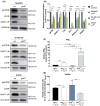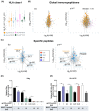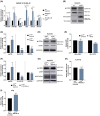Loss of p14 diminishes immunogenicity in melanoma via non-canonical Wnt signaling by reducing the peptide surface density
- PMID: 38807304
- PMCID: PMC11459041
- DOI: 10.1002/1878-0261.13660
Loss of p14 diminishes immunogenicity in melanoma via non-canonical Wnt signaling by reducing the peptide surface density
Abstract
Immunotherapy has achieved tremendous success in melanoma. However, only around 50% of advanced melanoma patients benefit from immunotherapy. Cyclin-dependent kinase inhibitor 2A (CDKN2A), encoding the two tumor-suppressor proteins p14ARF and p16INK4a, belongs to the most frequently inactivated gene loci in melanoma and leads to decreased T cell infiltration. While the role of p16INK4a has been extensively investigated, knowledge about p14ARF in melanoma is scarce. In this study, we elucidate the impact of reduced p14ARF expression on melanoma immunogenicity. Knockdown of p14ARF in melanoma cell lines diminished their recognition and killing by melanoma differentiation antigen (MDA)-specific T cells. Resistance was caused by a reduction of the peptide surface density of presented MDAs. Immunopeptidomic analyses revealed that antigen presentation via human leukocyte antigen class I (HLA-I) molecules was enhanced upon p14ARF downregulation in general, but absolute and relative expression of cognate peptides was decreased. However, this phenotype is associated with a favorable outcome for melanoma patients. Limiting Wnt5a signaling reverted this phenotype, suggesting an involvement of non-canonical Wnt signaling. Taken together, our data indicate a new mechanism limiting MDA-specific T cell responses by decreasing both absolute and relative MDA-peptide presentation in melanoma.
Keywords: CDKN2A; Wnt signaling; immunogenicity; immunotherapy; melanoma; peptide surface density.
© 2024 The Authors. Molecular Oncology published by John Wiley & Sons Ltd on behalf of Federation of European Biochemical Societies.
Conflict of interest statement
DL reports receiving honorarium and travel expenses from Genentech and is on the scientific advisory board of Oncovalent Therapeutics, neither of which have relevant interests associated with the results nor conduct of this study.
Figures







Similar articles
-
Mutations in the INK4a/ARF melanoma susceptibility locus functionally impair p14ARF.J Biol Chem. 2001 Nov 2;276(44):41424-34. doi: 10.1074/jbc.M105299200. Epub 2001 Aug 22. J Biol Chem. 2001. PMID: 11518711
-
Mutual exclusivity analysis of genetic and epigenetic drivers in melanoma identifies a link between p14 ARF and RARβ signaling.Mol Cancer Res. 2013 Oct;11(10):1166-78. doi: 10.1158/1541-7786.MCR-13-0006. Epub 2013 Jul 12. Mol Cancer Res. 2013. PMID: 23851445
-
Genetic Alterations in the INK4a/ARF Locus: Effects on Melanoma Development and Progression.Biomolecules. 2020 Oct 15;10(10):1447. doi: 10.3390/biom10101447. Biomolecules. 2020. PMID: 33076392 Free PMC article. Review.
-
Mutational analysis of selected genes in the TGFbeta, Wnt, pRb, and p53 pathways in primary uveal melanoma.Invest Ophthalmol Vis Sci. 2002 Sep;43(9):2845-51. Invest Ophthalmol Vis Sci. 2002. PMID: 12202501
-
The INK4a/ARF locus and melanoma.Oncogene. 2003 May 19;22(20):3092-8. doi: 10.1038/sj.onc.1206461. Oncogene. 2003. PMID: 12789286 Review.
References
-
- Ferlay J, Soerjomataram I, Dikshit R, Eser S, Mathers C, Rebelo M, et al. Cancer incidence and mortality worldwide: sources, methods and major patterns in GLOBOCAN 2012. Int J Cancer. 2015;136(5):E359–E386. - PubMed
-
- Marincola FM, Jaffee EM, Hicklin DJ, Ferrone S. Escape of human solid tumors from T‐cell recognition: molecular mechanisms and functional significance. Adv Immunol. 2000;74:181–273. - PubMed
MeSH terms
Substances
Associated data
- Actions
- Actions
- Actions
- Actions
Grants and funding
LinkOut - more resources
Full Text Sources
Medical
Molecular Biology Databases
Research Materials
Miscellaneous

